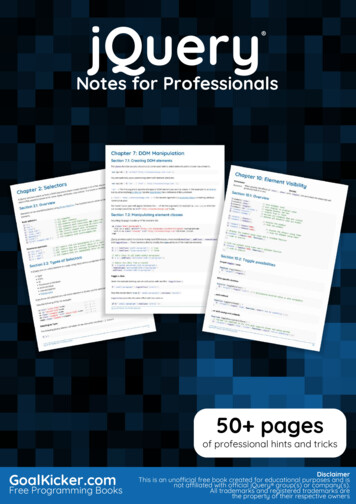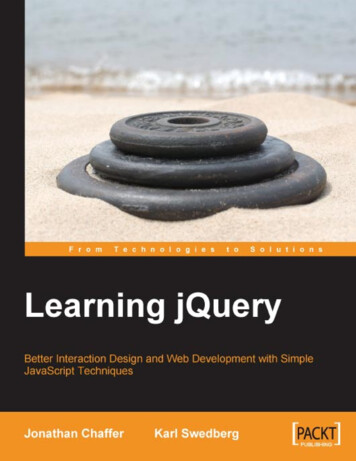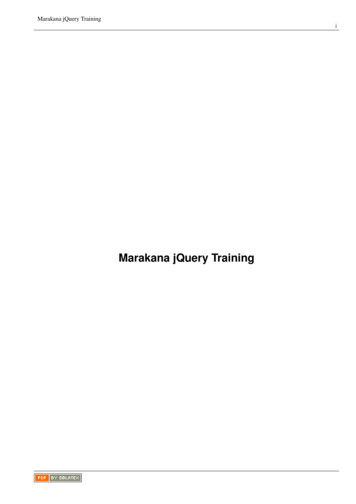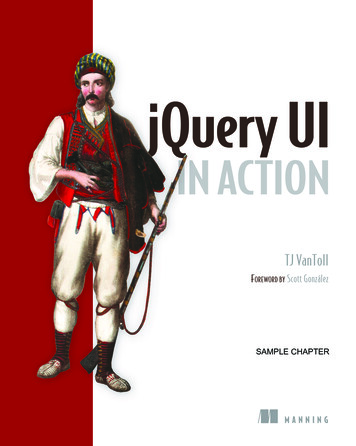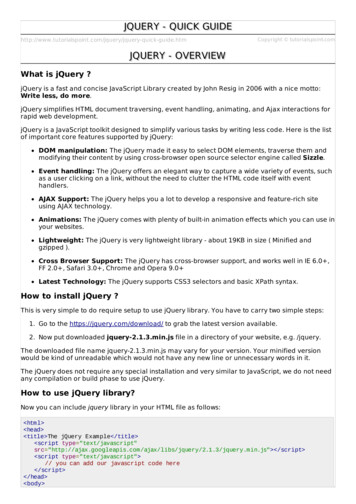
Transcription
JQUERY - QUICK uick-guide.htmCopyright tutorialspoint.comJQUERY - OVERVIEWWhat is jQuery ?jQuery is a fast and concise JavaScript Library created by John Resig in 2006 with a nice motto:Write less, do more.jQuery simplifies HTML document traversing, event handling, animating, and Ajax interactions forrapid web development.jQuery is a JavaScript toolkit designed to simplify various tasks by writing less code. Here is the listof important core features supported by jQuery:DOM manipulation: The jQuery made it easy to select DOM elements, traverse them andmodifying their content by using cross-browser open source selector engine called Sizzle.Event handling: The jQuery offers an elegant way to capture a wide variety of events, suchas a user clicking on a link, without the need to clutter the HTML code itself with eventhandlers.AJAX Support: The jQuery helps you a lot to develop a responsive and feature-rich siteusing AJAX technology.Animations: The jQuery comes with plenty of built-in animation effects which you can use inyour websites.Lightweight: The jQuery is very lightweight library - about 19KB in size ( Minified andgzipped ).Cross Browser Support: The jQuery has cross-browser support, and works well in IE 6.0 ,FF 2.0 , Safari 3.0 , Chrome and Opera 9.0 Latest Technology: The jQuery supports CSS3 selectors and basic XPath syntax.How to install jQuery ?This is very simple to do require setup to use jQuery library. You have to carry two simple steps:1. Go to the https://jquery.com/download/ to grab the latest version available.2. Now put downloaded jquery-2.1.3.min.js file in a directory of your website, e.g. /jquery.The downloaded file name jquery-2.1.3.min.js may vary for your version. Your minified versionwould be kind of unreadable which would not have any new line or unnecessary words in it.The jQuery does not require any special installation and very similar to JavaScript, we do not needany compilation or build phase to use jQuery.How to use jQuery library?Now you can include jquery library in your HTML file as follows: html head title The jQuery Example /title script type "text/javascript"src /jquery.min.js" /script script type "text/javascript" // you can add our javascript code here /script /head body
. /body /html How to call a jQuery library functions?As almost everything we do when using jQuery reads or manipulates the document object model(DOM), we need to make sure that we start adding events etc. as soon as the DOM is ready.If you want an event to work on your page, you should call it inside the (document).ready()function. Everything inside it will load as soon as the DOM is loaded and before the page contentsare loaded.To do this, we register a ready event for the document as follows: (document).ready(function() {// do stuff when DOM is ready});To call upon any jQuery library function, use HTML script tags as shown below: html head title The jQuery Example /title script type "text/javascript"src /jquery.min.js" /script script type "text/javascript" language "javascript" // ![CDATA[ (document).ready(function() { ("div").click(function() {alert("Hello world!");});});// ]] /script /head body div Click on this to see a dialogue box. /div /body /html How to use Custom Scripts?It is better to write our custom code in the custom JavaScript file : custom.js, as follows:/* Filename: custom.js */ (document).ready(function() { ("div").click(function() {alert("Hello world!");});});Now we can include custom.js file in our HTML file as follows: html head title The jQuery Example /title script type "text/javascript"src /jquery.min.js" /script script type "text/javascript"src "custom.js" /script /head
body div Click on this to see a dialogue box. /div /body /html Using Multiple Libraries:You can use multiple libraries all together without conflicting each others. For example you canuse jQuery and MooTool javascript libraries together.You can check jQuery noConflict Method for more detail.What is Next ?Do not worry too much if you did not understand above examples. You are going to grasp themvery soon in subsequent chapters.Next chapter would try to cover few basic concepts which are coming from conventionalJavaScript.JQUERY - BASICSjQuery is a framework built using JavaScript capabilities. So you can use all the functions and othercapabilities available in JavaScript.This chapter would explain most basic concepts but frequently used in jQuery.String:A string in JavaScript is an immutable object that contains none, one or many characters.Following are the valid examples of a JavaScript cript"really" a'really' aString"String'JavaScript String'JavaScript String"Numbers:Numbers in JavaScript are double-precision 64-bit format IEEE 754 values. They are immutable,just as strings.Following are the valid examples of a JavaScript Numbers:5350120.270.26Boolean:A boolean in JavaScript can be either true or false. If a number is zero, it defaults to false. If anempty string defaults to false:Following are the valid examples of a JavaScript alsetruefalsetrue
Objects:JavaScript supports Object concept very well. You can create an object using the object literal asfollows:var emp {name: "Zara",age: 10};You can write and read properties of an object using the dot notation as follows:// Getting object propertiesemp.name // Zaraemp.age// 10// Setting object propertiesemp.name "Daisy" // Daisyemp.age 20// 20Arrays:You can define arrays using the array literal as follows:var x [];var y [1, 2, 3, 4, 5];An array has a length property that is useful for iteration:var x [1, 2, 3, 4, 5];for (var i 0; i x.length; i ) {// Do something with x[i]}Functions:A function in JavaScript can be either named or anonymous. A named function can be definedusing function keyword as follows:function named(){// do some stuff here}An anonymous function can be defined in similar way as a normal function but it would not haveany name.A anonymous function can be assigned to a variable or passed to a method as shown below.var handler function (){// do some stuff here}JQuery makes a use of anonymous functions very frequently as follows: (document).ready(function(){// do some stuff here});Arguments:JavaScript variable arguments is a kind of array which has length property. Following exampleexplains it very well:
function func(x){console.log(typeof x, arguments.length);}func();// "undefined", 0func(1);// "number", 1func("1", "2", "3");// "string", 3The arguments object also has a callee property, which refers to the function you're inside of. Forexample:function func() {return arguments.callee;}func();// funcContext:JavaScript famous keyword this always refers to the current context. Within a function this contextcan change, depending on how the function is called: (document).ready(function() {// this refers to window.document}); ("div").click(function() {// this refers to a div DOM element});You can specify the context for a function call using the function-built-in methods call() andapply() methods.The difference between them is how they pass arguments. Call passes all arguments through asarguments to the function, while apply accepts an array as the arguments.function scope() {console.log(this, arguments.length);}scope() // window, 0scope.call("foobar", [1,2]); // "foobar", 1scope.apply("foobar", [1,2]); // "foobar", 2Scope:The scope of a variable is the region of your program in which it is defined. JavaScript variable willhave only two scopes.Global Variables: A global variable has global scope which means it is defined everywherein your JavaScript code.Local Variables: A local variable will be visible only within a function where it is defined.Function parameters are always local to that function.Within the body of a function, a local variable takes precedence over a global variable with thesame name:var myVar "global";// Declare a global variablefunction ( ) {var myVar "local";// Declare a local variabledocument.write(myVar); // local}Callback:
A callback is a plain JavaScript function passed to some method as an argument or option. Somecallbacks are just events, called to give the user a chance to react when a certain state istriggered.jQuery's event system uses such callbacks everywhere for example: ("body").click(function(event) {console.log("clicked: " event.target);});Most callbacks provide arguments and a context. In the event-handler example, the callback iscalled with one argument, an Event.Some callbacks are required to return something, others make that return value optional. Toprevent a form submission, a submit event handler can return false as follows: ("#myform").submit(function() {return false;});Closures:Closures are created whenever a variable that is defined outside the current scope is accessedfrom within some inner scope.Following example shows how the variable counter is visible within the create, increment, andprint functions, but not outside of them:function create() {var counter 0;return {increment: function() {counter ;},print: function() {console.log(counter);}}}var c create();c.increment();c.print();// 1This pattern allows you to create objects with methods that operate on data that isn't visible to theoutside world. It should be noted that data hiding is the very basis of object-orientedprogramming.Proxy Pattern:A proxy is an object that can be used to control access to another object. It implements the sameinterface as this other object and passes on any method invocations to it. This other object is oftencalled the real subject.A proxy can be instantiated in place of this real subject and allow it to be accessed remotely. Wecan saves jQuery's setArray method in a closure and overwrites it as follows:(function() {// log all calls to setArrayvar proxied jQuery.fn.setArray;jQuery.fn.setArray function() {console.log(this, arguments);return proxied.apply(this, arguments);};})();
The above wraps its code in a function to hide the proxied variable. The proxy then logs all calls tothe method and delegates the call to the original method. Using apply(this, arguments) guaranteesthat the caller won't be able to notice the difference between the original and the proxied method.Built-in Functions:JavaScript comes along with a useful set of built-in functions. These methods can be used tomanipulate Strings, Numbers and Dates.Following are important JavaScript functions:MethodDescriptioncharAt()Returns the character at the specified index.concat()Combines the text of two strings and returns a new string.forEach()Calls a function for each element in the array.indexOf()Returns the index within the calling String object of the first occurrence of thespecified value, or -1 if not found.length()Returns the length of the string.pop()Removes the last element from an array and returns that element.push()Adds one or more elements to the end of an array and returns the new lengthof the array.reverse()Reverses the order of the elements of an array -- the first becomes the last,and the last becomes the first.sort()Sorts the elements of an array.substr()Returns the characters in a string beginning at the specified location throughthe specified number of characters.toLowerCase()Returns the calling string value converted to lower case.toString()Returns the string representation of the number's value.toUpperCase()Returns the calling string value converted to uppercase.A complete list of built-in function is available here : Built-in Functions.The Document Object Model:The Document Object Model is a tree structure of various elements of HTML as follows: html head title The /head body div p This p This p This /div /body /html jQuery Example /title is a paragraph. /p is second paragraph. /p is third paragraph. /p Following are the important points about the above tree structure:
The html is the ancestor of all the other elements; in other words, all the other elementsare descendants of html .The head and body elements are not only descendants, but children of html , aswell.Likewise, in addition to being the ancestor of head and body , html is also theirparent.The p elements are children (and descendants) of div , descendants of body and html , and siblings of each other p elements.JQUERY - SELECTORSThe jQuery library harnesses the power of Cascading Style Sheets (CSS) selectors to let us quicklyand easily access elements or groups of elements in the Document Object Model (DOM).A jQuery Selector is a function which makes use of expressions to find out matching elements froma DOM based on the given criteria.The () factory function:All type of selectors available in jQuery, always start with the dollar sign and parentheses: ().The factory function () makes use of following three building blocks while selecting elements in agiven document:jQueryDescriptionTagName:Represents a tag name available in the DOM. For example ('p') selects allparagraphs in the document.TagID:Represents a tag available with the given ID in the DOM. For example ('#some-id')selects the single element in the document that has an ID of some-id.TagClass:Represents a tag available with the given class in the DOM. For example ('.someclass') selects all elements in the document that have a class of some-class.All the above items can be used either on their own or in combination with other selectors. All thejQuery selectors are based on the same principle except some tweaking.NOTE: The factory function () is a synonym of jQuery() function. So in case you are using anyother JavaScript library where sign is conflicting with some thing else then you can replace signby jQuery name and you can use function jQuery() instead of ().Example:Following is a simple example which makes use of Tag Selector. This would select all the elementswith a tag name p. html head title The jQuery Example /title script type "text/javascript"src /jquery.min.js" /script script type "text/javascript" language "javascript" (document).ready(function() {var pars ("p");for( i 0; i pars.length; i ){alert("Found paragraph: " pars[i].innerHTML);}});
/script /head body div p This is a paragraph. /p p This is second paragraph. /p p This is third paragraph. /p /div /body /html How to use Selectors?The selectors are very useful and would be required at every step while using jQuery. They get theexact element that you want from your HTML document.Following table lists down few basic selectors and explains them with examples.SelectorDescriptionNameSelects all elements which match with the given element Name.#IDSelects a single element which matches with the given ID.ClassSelects all elements which match with the given Class.Universal (*)Selects all elements available in a DOM.Multiple Elements E,F, GSelects the combined results of all the specified selectors E, F or G.Similar to above syntax and examples, following examples would give you understanding on usingdifferent type of other useful selectors: ('*'): This selector selects all elements in the document. ("p *"): This selector selects all elements that are children of a paragraph element. ("#specialID"): This selector function gets the element with . (".specialClass"): This selector gets all the elements that have the class of specialClass. ("li:not(.myclass)"): Selects all elements matched by li that do not have . ("a#specialID.specialClass"): This selector matches links with an id of specialID and aclass of specialClass. ("p a.specialClass"): This selector matches links with a class of specialClass declaredwithin p elements. ("ul li:first"): This selector gets only the first li element of the ul . ("#container p"): Selects all elements matched by p that are descendants of anelement that has an id of container. ("li ul"): Selects all elements matched by ul that are children of an element matchedby li ("strong em"): Selects all elements matched by em that immediately follow a siblingelement matched by strong . ("p ul"): Selects all elements matched by ul that follow a sibling element matched by p . ("code, em, strong"): Selects all elements matched by code or em or strong .
("p strong, .myclass"): Selects all elements matched by strong that are descendantsof an element matched by p as well as all elements that have a class of myclass. (":empty"): Selects all elements that have no children. ("p:empty"): Selects all elements matched by p that have no children. ("div[p]"): Selects all elements matched by div that contain an element matched by p . ("p[.myclass]"): Selects all elements matched by p that contain an element with a classof myclass. ("a[@rel]"): Selects all elements matched by a that have a rel attribute. ("input[@name myname]"): Selects all elements matched by input that have a namevalue exactly equal to myname. ("input[@name myname]"): Selects all elements matched by input that have aname value beginning with myname. ("a[@rel self]"): Selects all elements matched by a that have rel attribute valueending with self ("a[@href* domain.com]"): Selects all elements matched by a that have an hrefvalue containing domain.com. ("li:even"): Selects all elements matched by li that have an even index value. ("tr:odd"): Selects all elements matched by tr that have an odd index value. ("li:first"): Selects the first li element. ("li:last"): Selects the last li element. ("li:visible"): Selects all elements matched by li that are visible. ("li:hidden"): Selects all elements matched by li that are hidden. (":radio"): Selects all radio buttons in the form. (":checked"): Selects all checked boxex in the form. (":input"): Selects only form elements (input, select, textarea, button). (":text"): Selects only text elements (input[type text]). ("li:eq(2)"): Selects the third li element ("li:eq(4)"): Selects the fifth li element ("li:lt(2)"): Selects all elements matched by li element before the third one; in otherwords, the first two li elements. ("p:lt(3)"): selects all elements matched by p elements before the fourth one; in otherwords the first three p elements. ("li:gt(1)"): Selects all elements matched by li after the second one. ("p:gt(2)"): Selects all elements matched by p after the third one. ("div/p"): Selects all elements matched by p that are children of an element matchedby div . ("div//code"): Selects all elements matched by code that are descendants of anelement matched by div . ("//p//a"): Selects all elements matched by a that are descendants of an element
matched by p ("li:first-child"): Selects all elements matched by li that are the first child of theirparent. ("li:last-child"): Selects all elements matched by li that are the last child of theirparent. (":parent"): Selects all elements that are the parent of another element, including text. ("li:contains(second)"): Selects all elements matched by li that contain the textsecond.You can use all the above selectors with any HTML/XML element in generic way. For example ifselector ("li:first") works for li element then ("p:first") would also work for p element.JQUERY - ATTRIBUTESSome of the most basic components we can manipulate when it comes to DOM elements are theproperties and attributes assigned to those elements.Most of these attributes are available through JavaScript as DOM node properties. Some of themore common properties are:classNametagNameidhreftitlerelsrcConsider the following HTML markup for an image element: img/ In this element's markup, the tag name is img, and the markup for id, src, alt, class, and titlerepresents the element's attributes, each of which consists of a name and a value.jQuery gives us the means to easily manipulate an element's attributes and gives us access to theelement so that we can also change its properties.Get Attribute Value:The attr() method can be used to either fetch the value of an attribute from the first element inthe matched set or set attribute values onto all matched elements.Example:Following is a simple example which fetches title attribute of em tag and set div value withthe same value: html head title The jQuery Example /title script type "text/javascript"src /jquery.min.js" /script script type "text/javascript" language "javascript"
(document).ready(function() {var title ("em").attr("title"); ("#divid").text(title);}); /script /head body div em title "Bold and Brave" This is first paragraph. /em p This is second paragraph. /p div /div /div /body /html Set Attribute Value:The attr(name, value) method can be used to set the named attribute onto all elements in thewrapped set using the passed value.Example:Following is a simple example which set src attribute of an image tag to a correct location: html head title The jQuery Example /title script type "text/javascript"src /jquery.min.js" /script script type "text/javascript" language "javascript" (document).ready(function() { ("#myimg").attr("src", "images/jquery.jpg");}); /script /head body div img / /div /body /html Applying Styles:The addClass( classes ) method can be used to apply defined style sheets onto all the matchedelements. You can specify multiple classes separated by space.Example:Following is a simple example which sets class attribute of a para p tag: html head title The jQuery Example /title script type "text/javascript"src /jquery.min.js" /script script type "text/javascript" language "javascript" (document).ready(function() { ("em").addClass("selected"); ("#myid").addClass("highlight");}); /script
style .selected { color:red; }.highlight { background:yellow; } /style /head body em title "Bold and Brave" This is first paragraph. /em p This is second paragraph. /p /body /html Useful Attribute Methods:Following table lists down few useful methods which you can use to manipulate attributes andproperties:MethodsDescriptionattr( properties )Set a key/value object as properties to all matched elements.attr( key, fn )Set a single property to a computed value, on all matched elements.removeAttr( name )Remove an attribute from each of the matched elements.hasClass( class )Returns true if the specified class is present on at least one of the set ofmatched elements.removeClass( class )Removes all or the specified class(es) from the set of matchedelements.toggleClass( class )Adds the specified class if it is not present, removes the specified class ifit is present.html( )Get the html contents (innerHTML) of the first matched element.html( val )Set the html contents of every matched element.text( )Get the combined text contents of all matched elements.text( val )Set the text contents of all matched elements.val( )Get the input value of the first matched element.val( val )Set the value attribute of every matched element if it is called on input but if it is called on select with the passed option valuethen passed option would be selected, if it is called on check box orradio box then all the matching check box and radiobox would bechecked.Similar to above syntax and examples, following examples would give you understanding on usingvarious attribute methods in different situation: ("#myID").attr("custom") : This would return value of attribute custom for the firstelement matching with ID myID. ("img").attr("alt", "Sample Image"): This sets the alt attribute of all the images to a newvalue "Sample Image". ("input").attr({ value: "", title: "Please enter a value" }); : Sets the value of all input elements to the empty string, as well as sets The jQuery Example to the stringPlease enter a value. ("a[href http://]").attr("target"," blank"): Selects all links with an href attributestarting with http:// and set its target attribute to blank
("a").removeAttr("target") : This would remove target attribute of all the links. ("form").submit(function() { (":submit",this).attr("disabled", "disabled");}); : Thiswould modify the disabled attribute to the value "disabled" while clicking Submit button. ("p:last").hasClass("selected"): This return true if last p tag has associatedclassselected. ("p").text(): Returns string that contains the combined text contents of all matched p elements. ("p").text(" i Hello World /i "): This would set " I Hello World /I " as text contentof the matching p elements ("p").html() : This returns the HTML content of the all matching paragraphs. ("div").html("Hello World") : This would set the HTML content of all matching div toHello World. ("input:checkbox:checked").val() : Get the first value from a checked checkbox ("input:radio[name bar]:checked").val(): Get the first value from a set of radio buttons ("button").val("Hello") : Sets the value attribute of every matched element button . ("input").val("on") : This would check all the radio or check box button whose value is"on". ("select").val("Orange") : This would select Orange option in a dropdown box with optionsOrange, Mango and Banana. ("select").val("Orange", "Mango") : This would select Orange and Mango options in adropdown box with options Orange, Mango and Banana.JQUERY - DOM TRAVERSINGjQuery is a very powerful tool which provides a variety of DOM traversal methods to help us selectelements in a document randomly as well as in sequential method.Most of the DOM Traversal Methods do not modify the jQuery object and they are used to filter outelements from a document based on given conditions.Find Elements by index:Consider a simple document with the following HTML content: html head title The JQuery Example /title /head body div ul li list item 1 /li li list item 2 /li li list item 3 /li li list item 4 /li li list item 5 /li li list item 6 /li /ul /div /body /html Above every list has its own index, and can be located directly by using eq(index) method asbelow example.
Every child element starts its index from zero, thus, list item 2 would be accessed by using ("li").eq(1) and so on.Example:Following is a simple example which adds the color to second list item. html head title The JQuery Example /title script type "text/javascript"src /jquery.min.js" /script script type "text/javascript" language "javascript" (document).ready(function() { ("li").eq(2).addClass("selected");}); /script style .selected { color:red; } /style /head body div ul li list item 1 /li li list item 2 /li li list item 3 /li li list item 4 /li li list item 5 /li li list item 6 /li /ul /div /body /html Filtering out Elements:The filter( selector ) method can be used to filter out all elements from the set of matchedelements that do not match the specified selector(s). The selector can be written using anyselector syntax.Example:Following is a simple example which applies color to the lists associated with middle class: html head title The JQuery Example /title script type "text/javascript"src /jquery.min.js" /script script type "text/javascript" language "javascript" (document).ready(function() { ("li").filter(".middle").addClass("selected");}); /script style .selected { color:red; } /style /head body div ul li list item 1 /li
li list li list li list li list li list /ul /div /body /html itemitemitemitemitem2 /li 3 /li 4 /li 5 /li 6 /li Locating Descendent Elements :The find( selector ) method can be used to locate all the descendent elements of a particulartype of elements. The selector can be written using any selector syntax.Example:Following is an example which selects all the span elements available inside different p elements: html head title The JQuery Example /title script type "text/javascript"src /jquery.min.js" /script script type "text/javascript" language "javascript" (document).ready(function() { ("p").find("span").addClass("selected");}); /script style .selected { color:red; } /style /head body p This is 1st paragraph and span THIS IS RED /span /p p This is 2nd paragraph and span THIS IS ALSO RED /span /p /body /html JQuery DOM Traversing Methods:Following table lists down useful methods which you can use to filter out various elements from alist of DOM elements:SelectorDescriptioneq( index )Reduce the set of matched elements to a single element.filter( selector )Removes all elements from the set of matched elements that do notmatch the specified selector(s).filter( fn )Removes all elements from the set of matched elements that do notmatch the specified function.is( selector )Checks the current selection against an expression and returns true, ifat least one element of the selection fits the given selector.map( callback )Translate a set of elements in the jQuery object into another set ofvalues in a jQuery array (which may, or may not contain elements).not( selector )Removes elements matching the specified selector from the set ofmatched elements.
slice( start, [end] )Selects a subset of the matched elements.Following table lists down other useful methods which you can use to locate various elements in aDOM:SelectorDescriptionadd( selector )Adds more elements, matched by the given selector, to the set ofmatched elements.andSelf( )Add the previous selection to the current selection.children( [selector])Get a set of elements
What is jQuery ? jQuery is a fast and concise JavaScript Library created by John Resig in 2006 with a nice motto: Write less, do more. jQuery simplifies HTML document traversing, event handling, animating, and Ajax interactions for rapid web development. jQuery is a JavaScript toolkit designed to simplify various tasks by writing less code.

